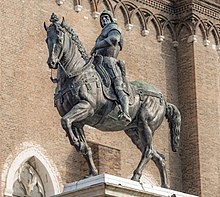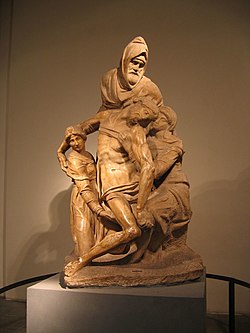Renaissance sculpture
In this context we must take into account the exception of the Flemish artists in northern Europe, who, in addition to overcoming the figurative style of the Gothic, promoted a Renaissance foreign to the Italian one, especially in the field of painting.[1] The rebirth of antiquity with the abandonment of the medieval, which for Giorgio Vasari "had been a world of Goths",[2] and the recognition of the classics with all their variants and nuances was a phenomenon that developed almost exclusively in Italian Renaissance sculpture.[5] A fundamental role was played by the figure of the Maecenas, represented by the church and noblemen who, with their patronage, obtained social prestige and political propaganda, and covered all themes: religious, mythological, daily life, portraits of characters, etc.[15] The first Renaissance free-standing sculpture that showed the harmony of the nude was Donatello's David during the Quattrocento, in which the influence of Praxiteles' style could be appreciated with a slight contrapposto to achieve balance in the composition.[16] Sculpture evolved in its conception and in the compositions of its groups, until it reached the serpentinata typical of Mannerism, which is clearly shown in works such as the Florentine Pietà (Michelangelo) or the Rape of the Sabine Women (Giambologna).Leonardo da Vinci's studies led to a change in the representation of the horse, which was placed on its hind legs and in an attitude of pouncing on the enemy; the idea was probably taken from reliefs of ancient sarcophagi.Its antecedents took place in the south of Italy, in the court of Frederick II, under whose protection an artistic school was born that already brought anticipated lights of what would be the Renaissance of the 15th century.[28] Andrea del Verrocchio (1435–1488) was greatly influenced by the works of Donatello to the point of repeating some of his themes, such as the David in Florence or the equestrian statue of the condottiere Colleone in Venice (both in bronze).Agostino di Duccio (1418–1481) was also a follower of Donatello, imitating his famous schiacciato relief style,[29] especially in the decoration of the façade of the oratory of San Bernardino in Perugia and in the Malatesta temple in Rimini.Florence remained an important Renaissance city, and masterpieces of art continued to be made in the Tuscan capital during this period, such as the David, the sepulchres of the Medici Chapels, Cellini's Perseus, etc.But from the year in which the popes began to commission him to build grandiose monuments, he created a gigantic style, very vigorous, full of passion, independent and called terribilità uniquely his own.In Mannerism, sculpture rejected classicism by seeking curvilinear and dynamic forms, the so-called serpentinata or composition of curves and counter-curves in which the bodies turned in on themselves, in narrow spaces and sometimes with very pronounced foreshortenings.Of this type are two works by Ligier Richier with polychrome in black, white and gray: the Memorial of René de Chalon in Bar-le-Duc in which the partially fleshless skeleton tends a heart towards the sky; and the emaciated recumbent body of Philippa of Guelders in the Church des Cordeliers in Nancy.[36] Michel Colombe, sculptor of Queen Anne of Brittany at the beginning of the 16th century, who commissioned the tomb of her parents, Duke Francis II and Margaret de Foix in the cathedral of Nantes, stands out with the influence of Italian work.The dead Christ resembles the engravings of Parmigianino, as the figures look for the diagonals and the foreshortenings are spectacular, with the folds of the clothes tight and very thin, recalling the reliefs of classical antiquity.[41] Alonso Berruguete and Juan de Juni, of French origin and with a workshop in Valladolid, author of the major altarpieces in the churches of Santiago and La Antigua, as well as many other works found in Segovia, Ciudad Rodrigo and other towns in Castile, stood out in the second third of the 16th century and continued until 1577.[42] The prosperity of the Germanic cities was consolidated with the extension of the Gothic period, producing in the first decades of the 16th century the introduction of Renaissance sculpture with the influence of the Italian Florentine school.The German sculptors found it difficult to abandon the Gothic costumes and for their characters to acquire the classical spirit, as can be clearly seen in the works of Veit Stoss, in the altarpiece of the Virgin in St. Mary in Krakow, in the reliefs of the cathedral of Bamberg or in the Annunciation of the Rosary in the church of St. Lawrence in Nuremberg.Albrecht Dürer was also involved in this work, for which he designed the Head of King Arthur and made the full body sculpture Vischer, with the decoration and armor in medieval style, but with the clear contrapposto of a hero of Antiquity.In the realization of altarpieces, choir stalls and religious furnishings including sculpture, wood carving was used, in which Renaissance elements were elaborated in the style of those made in the Lombard part of Italy.In Utrecht there are several statues by the sculptor Uries and Kéyser, in which Renaissance naturalism can be seen in the anatomical details and in the folds of the vestments, with full acceptance of the new style in the second half of the sixteenth century.Jacques du Broeuq, master of John of Bologna, was appointed architect and court sculptor by Mary of Austria, daughter of Charles I of Spain, for whom he carried out numerous works, among them a set of sculptures in alabaster for the choir of Sainte-Waudru de Mons.It is made of marble and gilded bronze, with the recumbent figures of the monarchs and at each corner of the tomb angels holding coats of arms; it is in a chapel of Westminster Abbey in London.Only in the superb pantheons and in commemorative statues of characters had since then some life in plastic arts, such as the one made by the Englishman Richard Parker for the tomb of the Earl of Rutland (1543) in Bottesford.[48] The Italian influence was replaced by the French and by the arrival of Flemish artists, among them Gerard Johnson (also called Garret Jansen), who made the tomb of the Earl of Southampton in Titchfield and the funerary monument in honor of William Shakespeare in Stratford.In 1517 he was commissioned the central portico of the Jerónimos Monastery in Belém and the praying figures of King Manuel and Queen Maria; among the many works of this sculptor is the alabaster altarpiece of the Pena Palace for the city of Sintra.[51] Two other French sculptors were also in Coimbra: Juan de Ruan and Felipe Duarte or Orarte, who came from Toledo and who was hired to make the group of The Supper, which was completed in 1534 with an extraordinary realism in agitated and impetuous attitudes.In the middle of this century the Spanish influence could be appreciated in several works of the monastery of Belém, as in a wooden Crucified whose style is similar to that of the circle of Diego de Siloé.In Ecuador, it was precisely the Franciscan missionaries of Flemish origin Pedro Gosseal and Jodoco Ricke who founded the first school in the convent of San Francisco in Quito, teaching knowledge in the art of architecture and carving, both in stone and wood, as well as religion and letters.The local artists achieved good interpretations mixed with motifs of their tradition with the ingenuity of the faces of the images as well as the polychrome with more primary colors and much more striking, where it can be seen in the altarpieces that were built during the fifteenth century in Mexico, as well as in the decoration used in the baptismal fonts and in the crosses of the conventual courtyards.

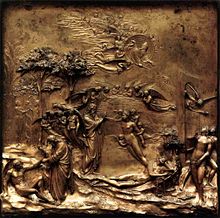


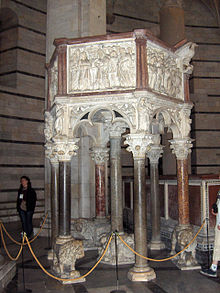
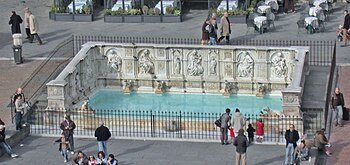

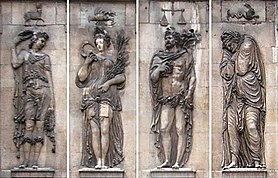
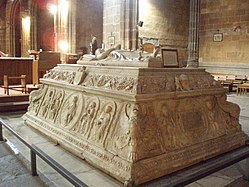








Vatican PietàRenaissanceMichelangelo Buonarroti.sculptureclassical antiquityGothicGiorgio VasariItalian Renaissance sculptureEquestrian statue of Bartolomeo ColleonibronzeVerrocchiohumanistnaturalisticanatomyBeautycontrappostoDonatelloMichelangeloperspectiveterribilitàportraitsglypticsMiddle AgescameosmarbleAntonio PollaiuoloAndrea del VerrocchioMediciLeonardo da VinciMantuanPier Jacopo Alari BonacolsiGermanyTerracottaAntonio RossellinoMatteo CivitaliPietro TorrigianoMuseum of Fine Arts of SevilleLuca della RobbiatabernacleSanta Maria NovellaFlorencetondosMadonnasAndrea della RobbiaAbduction of a Sabine WomanFlemishGiambolognatrepanBenvenuto CellinicastingSculpture in the roundVitruviusDonatello's DavidQuattrocentoPraxitelesMichelangelo's DavidGuido MazzoniNiccolò dell'ArcaFlorentine Pietàthe Rape of the Sabine WomenRelief sculptureGhibertiGiuliano de' MedicistiacciatoGiottocathedral of BadajozLorenzo Suárez de Figueroa.cathedral of BarcelonaBartolomé Ordóñeztriumphal archPlateresqueheraldic escutcheonAlbertiFrancesco LauranaEquestrian statueMarcus AureliusSt. John LateranGattamelataColleonihistoriography16th centuriesCinquecentoGothic artFrederick IITuscanyNicola PisanoGiovanni PisanoAndrea PisanoBaptistery of FlorenceNino PisanoPulpit in the Pisa BaptisteryNicolò Pisanobaptistery of the cathedral of this cityLorenzo GhibertiJacopo della QuerciaAgostino di DuccioFlorence BaptisteryBrunelleschiOld Sacristy of San LorenzocondottieroErasmo de NarniGaia FountainGenesisSpedale degli InnocentiGiovanni della RobbiaLorenzo de' MedicicondottiereBargello MuseumschiacciatoMalatesta templeJuan de JuniBolognaModenaMazzonioratory of San BernardinoPerugiaclassicismmannerismLaocoön and His SonsMadonna of BrugesPietàBacchusPope Julius IIbasilicaSan Pietro in VincoliSansovino
